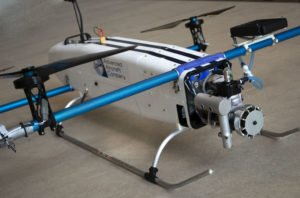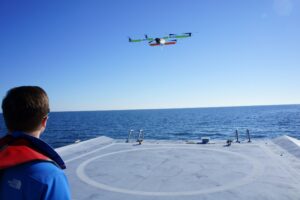 Advance Aircraft Company’s gasoline-electric hybrid multirotor for endurance drone operations stays aloft up to eight times longer than conventional multirotors.
Advance Aircraft Company’s gasoline-electric hybrid multirotor for endurance drone operations stays aloft up to eight times longer than conventional multirotors.
By DRONELIFE Staff Writer Jim Magill
A fledgling drone manufacturing company, led by a former NASA aeronautical engineer, recently announced the launch of its first commercial product, a multirotor unmanned aircraft whose gasoline-electric hybrid engine allows it to stay aloft up to eight times longer than conventional multirotor drones.
On August 4, Advance Aircraft Company (AAC), based Hampton, Virginia, unveiled its Hybrid Advanced Multirotor (HAMR) unmanned aircraft system. Key features of the drone are its high-performance gas-electric hybrid propulsion system and aerodynamic airframe design, which enable long-endurance drone operations, giving AAC’s customers a significant competitive advantage by doubling the productivity of their drone pilots, said the company’s founder and CEO Bill Fredericks.
“Our customers generate revenue by the acre and they pay their pilots by the hour, so productivity is important to them,” Fredericks said in an interview.
The HAMR hybrid propulsion system incorporates an electronic fuel-injected and computer-controlled 35cc single-piston engine. This configuration drives an integrated 2,000-W generator that powers six independent, brushless DC electric motors and a backup battery. The aircraft’s architecture allows it to remain airborne for up to 3.5 hours at a time, six to eight times longer than a conventional battery-powered multirotor aircraft.
Unlike more conventional battery-powered multirotor drones, which on average only yield about 3.4 hours of productive flight time during a typical eight-hour day, HAMR’s pilots are able to achieve up to six hours of productive flight time per day, Fredericks said.
Although the company’s UAVs, which are manufactured in the US, cost four to six times what a comparable Chinese drone would cost, the increase in productivity allows the HAMR to pay for itself within a matter of months, Fredericks said.
Lifelong love of aviation
 The launch of a commercial unmanned aircraft system represents the culmination of a long-held dream for Fredericks, himself a private pilot, licensed in the operation of gliders and single- and multiple-engine manned aircraft.
The launch of a commercial unmanned aircraft system represents the culmination of a long-held dream for Fredericks, himself a private pilot, licensed in the operation of gliders and single- and multiple-engine manned aircraft.
“I started flying gliders at 13 years old,” he said. “I own my own plane, a Piper Lance.”
Fredericks got his degree in aeronautical engineering at Purdue University where he graduated fourth in his class. He served in the Marine Corps as an artillery officer and deployed to Afghanistan in 2011. After leaving the Marines, he worked as an aeronautics engineer at NASA’s Langley Research Center in Virginia. “I’m the only person who can say they’re both a Marine and a legit NASA rocket scientist,” he said.
While at NASA, Fredericks led the project to develop Greased Lightning, a 10-engine remotely piloted aircraft capable of taking off like a helicopter and flying like an airplane. After successfully building and test flying the aircraft, “We put the project on the shelf and broke up the team to work on the next jobs,” he said.
“That’s when I said to myself, ‘Do I still want to be a government civil servant or do I want to see this technology, which we had just proved was feasible, commercialized?” he said. With the goal of developing a commercial unmanned aircraft system in mind, he transitioned out of the government service and founded AAC in 2017.
Now, after four years of development, testing and validation, the company on August 4 entered into the unmanned systems market with HAMR. AAC also announced the completion of a second funding round by its investors. The latest funding round of $850,000, led by Shenandoah Valley Angel Investors with investment from CIT Gap Funds, brings the company’s total funding to over $2 million.

Because it’s a multirotor vehicle that can fly at low speeds, the HAMR is well suited for surveying and mapping and other applications that require LiDAR, Fredericks said. Other potential commercial applications for the HAMR include: infrastructure inspection and security, and atmospheric and marine research. In the security and public safety arena potential uses include: long-endurance overwatch, intelligence, surveillance and reconnaissance (ISR), and search and rescue missions.
Fredericks said the aircraft’s modular design allows the company to customize the drones to fit the customer’s needs. For example, the HAMR features two swappable payload bays, one in the nosecone and one in the aircraft’s belly, giving customers a great deal of flexibility in designing the drone’s configuration.
As an example, one of AAC’s early customers, an oil and gas company, had wanted to adapt the drone to detect fugitive methane leaks from its operations. Fredericks said.
“They love the fact that the vehicle is open-platform with two different payload bays, so they’re integrating three different types of methane sniffers,” he said. The aircraft is configured to carry an optical-gas imaging sensor, a laser-based methane detector and an in-situ sniffer for flying directly through the methane plume.
Another feature of the HAMR, which its designers borrowed from the world of manned aviation, is the use of modular line replaceable units (LRU), which can be easily switched out, eliminating costly down time for the aircraft.
“With an airliner, if something breaks, the mechanic can swap out a spare LRU with very minimal downtime. You can get the aircraft back in service and you can fix the broken LRU at another time,” Fredericks said. “We’ve architected our aircraft in the same way.”
Although AAC currently exists only as a drone manufacturer, the company hopes to expand into offering other drone-related services, such as software subscriptions, which will increase customers’ options for using their vehicles’ payloads and sensors.
“We’re first starting with a very simple business model. We build a widget and then we sell the widget. However, we’re looking at expanding our business model, by offering a digital platform, in addition to physically selling the vehicle,” Fredericks said. “Right now, we sell an aircraft and soon we’ll be selling an aircraft with a digital platform in addition to the physical platform.”
 Jim Magill is a Houston-based writer with almost a quarter-century of experience covering technical and economic developments in the oil and gas industry. After retiring in December 2019 as a senior editor with S&P Global Platts, Jim began writing about emerging technologies, such as artificial intelligence, robots and drones, and the ways in which they’re contributing to our society. In addition to DroneLife, Jim is a contributor to Forbes.com and his work has appeared in the Houston Chronicle, U.S. News & World Report, and Unmanned Systems, a publication of the Association for Unmanned Vehicle Systems International.
Jim Magill is a Houston-based writer with almost a quarter-century of experience covering technical and economic developments in the oil and gas industry. After retiring in December 2019 as a senior editor with S&P Global Platts, Jim began writing about emerging technologies, such as artificial intelligence, robots and drones, and the ways in which they’re contributing to our society. In addition to DroneLife, Jim is a contributor to Forbes.com and his work has appeared in the Houston Chronicle, U.S. News & World Report, and Unmanned Systems, a publication of the Association for Unmanned Vehicle Systems International.







[…] post Former NASA Rocket Scientist Designs a Drone: and it Looks Totally Different than a Conventional Mul… appeared first on […]